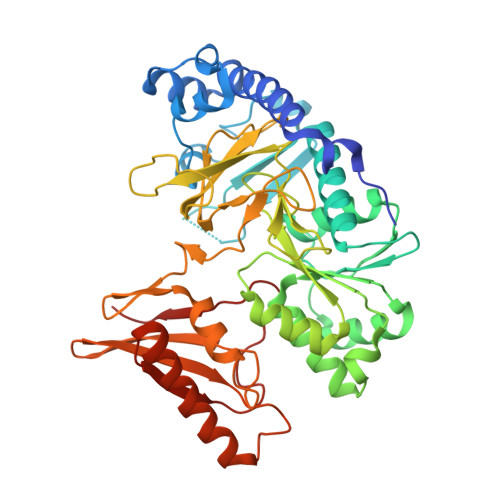Defining a Structural and Kinetic Rationale for Paralogous Copies of Phenylacetate-Coa Ligases from the Cystic Fibrosis Pathogen Burkholderia Cenocepacia J2315.
Law, A., Boulanger, M.J.(2011) J Biol Chem 286: 15577
- PubMed: 21388965
- DOI: https://doi.org/10.1074/jbc.M111.219683
- Primary Citation of Related Structures:
2Y27, 2Y4N, 2Y4O - PubMed Abstract:
The phenylacetic acid (PAA) degradation pathway is the sole aerobic route for phenylacetic acid metabolism in bacteria and facilitates degradation of environmental pollutants such as styrene and ethylbenzene. The PAA pathway also is implicated in promoting Burkholderia cenocepacia infections in cystic fibrosis patients. Intriguingly, the first enzyme in the PAA pathway is present in two copies (paaK1 and paaK2), yet each subsequent enzyme is present in only a single copy. Furthermore, sequence divergence indicates that PaaK1 and PaaK2 form a unique subgroup within the adenylate-forming enzyme (AFE) superfamily. To establish a biochemical rationale for the existence of the PaaK paralogs in B. cenocepacia, we present high resolution x-ray crystal structures of a selenomethionine derivative of PaaK1 in complex with ATP and adenylated phenylacetate intermediate complexes of PaaK1 and PaaK2 in distinct conformations. Structural analysis reveals a novel N-terminal microdomain that may serve to recruit subsequent PAA enzymes, whereas a bifunctional role is proposed for the P-loop in stabilizing the C-terminal domain in conformation 2. The potential for different kinetic profiles was suggested by a structurally divergent extension of the aryl substrate pocket in PaaK1 relative to PaaK2. Functional characterization confirmed this prediction, with PaaK1 possessing a lower K(m) for phenylacetic acid and better able to accommodate 3' and 4' substitutions on the phenyl ring. Collectively, these results offer detailed insight into the reaction mechanism of a novel subgroup of the AFE superfamily and provide a clear biochemical rationale for the presence of paralogous copies of PaaK of B. cenocepacia.
Organizational Affiliation:
Department of Biochemistry & Microbiology, University of Victoria, Victoria, British Columbia V8W 3P6, Canada.




















